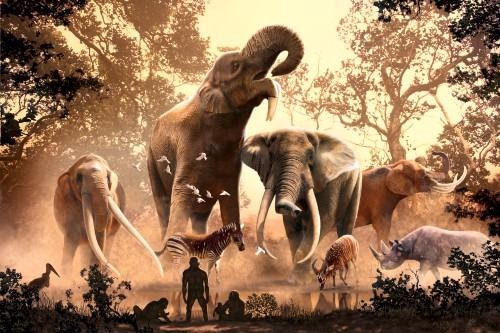Jul 2 2021
A new study reveals that elephants and their antecedents went extinct due to waves of extreme global environmental change, and not overhunting by early humans.
 Dusk falls on East Africa’s Turkana Basin 4 million years ago, where our early upright-walking ape ancestors, Australopithecus anamensis (foreground), shared their habitat with several coexisting proboscidean species, as part of a spectacular herbivore community containing some progenitors of today’s charismatic East African animals. Image Credit: Julius Csotonyi.
Dusk falls on East Africa’s Turkana Basin 4 million years ago, where our early upright-walking ape ancestors, Australopithecus anamensis (foreground), shared their habitat with several coexisting proboscidean species, as part of a spectacular herbivore community containing some progenitors of today’s charismatic East African animals. Image Credit: Julius Csotonyi.
The study was recently published in the journal Nature, Ecology & Evolution and contradicts the claim that prehistoric elephants, mammoths and mastodons were pushed to extinction across several millennia due to over-slaughtering by early humans.
The study suggests that the extinction of the last mammoths and mastodons at the end of the last Ice Age marked the end of advancing climate-induced global decline among elephants over millions of years.
The three endangered species of elephants restricted to the African and Asian tropics are the last survivors of a once far more diverse and widespread population of herbivores called proboscideans.
The proboscideans also include the now extinct mastodons, deinotheres and stegodonts. About 700,000 years ago, three types of elephants habituated in England — two of which were mammoth species and the equally prodigious straight-tusked elephant.
An international group of paleontologists from the Alcalá, Bristol and Helsinki universities led an in-depth analysis to date on the rise and fall of elephants and their antecedents. The study examined the adaption of 185 different species spanning over 60 million years of evolution beginning from North Africa.
To trace this rich evolutionary history, the researchers surveyed available museum fossils across the globe, from London’s Natural History Museum to Moscow’s Paleontological Institute. An investigation of details such as skull shape, body size and the chewing surface of their teeth helped them conclude that all proboscideans belonged to one of the eight sets of adaptive strategies.
Remarkably for 30 million years, the entire first half of proboscidean evolution, only two of the eight groups evolved.
Dr. Zhang Hanwen, Study Co-Author and Honorary Research Associate, School of Earth Sciences, University of Bristol
“Most proboscideans over this time were nondescript herbivores ranging from the size of a pug to that of a boar. A few species got as big as a hippo, yet these lineages were evolutionary dead-ends. They all bore little resemblance to elephants,” added Dr. Hanwen.
The evolution of proboscideans faced a dramatic change some 20 million years ago, as the Afro-Arabian plate collided into the Eurasian continent. Thus, Arabia stood as an important corridor for the migration of mastodont-grade species to explore new habitats in Eurasia, and subsequently into North America through the Bering Land Bridge.
The immediate impact of proboscidean dispersals beyond Africa was quantified for the very first time in our study.
Dr. Juan Cantalapiedra, Study Lead Author and Senior Research Fellow, University of Alcalá
“Those archaic North African species were slow-evolving with little diversification, yet we calculated that once out of Africa proboscideans evolved 25 times faster, giving rise to a myriad of disparate forms, whose specializations permitted niche partition between several proboscidean species in the same habitats,” added Dr. Cantalapiedra.
Dr. Cantalapiedra further stated, “One case in point being the massive, flattened lower tusks of the ‘shovel-tuskers’. Such coexistence of giant herbivores was unlike anything in today’s ecosystems.”
The aim of the game in this boom period of proboscidean evolution was ‘adapt or die’. Habitat perturbations were relentless, pertained to the ever-changing global climate, continuously promoting new adaptive solutions while proboscideans that didn’t keep up were literally, left for dead.
Dr. Zhang Hanwen, Study Co-Author and Honorary Research Associate, School of Earth Sciences, University of Bristol
“The once greatly diverse and widespread mastodonts were eventually reduced to less than a handful of species in the Americas, including the familiar Ice Age American mastodon,” added Dr. Hanwen.
About 3 million years ago, the elephants and stegodonts belonging to Africa and eastern Asia emerged successful in this unremitting evolutionary ratchet. However, the changes associated with the following ice ages forced the surviving species to adapt to new and more severe conditions.
Woolly mammoth, which had thick, shaggy hair and big tusks for fetching vegetation that was covered by thick snow, was the most extreme example.
Through the research, the team identified that the final extinction peaks of proboscideans started around 2.4 million years ago in Africa, 160,000 years ago in Eurasia, and about 75,000 years ago in the Americas.
“It is important to note that these ages do not demarcate the precise timing of extinctions, but rather indicate the points in time at which proboscideans on the respective continents became subject to higher extinction risk,” stated Dr. Cantalapiedra.
The results do not match with theories of early human expansion and their improved capabilities to hunt down megaherbivores.
“We didn’t foresee this result. It appears as if the broad global pattern of proboscidean extinctions in recent geological history could be reproduced without accounting for impacts of early human diasporas. Conservatively, our data refutes some recent claims regarding the role of archaic humans in wiping out prehistoric elephants, ever since big game hunting became a crucial part of our ancestors’ subsistence strategy around 1.5 million years ago,” commented Dr. Cantalapiedra.
“Although this isn’t to say we conclusively disproved any human involvement. In our scenario, modern humans settled on each landmass after proboscidean extinction risk had already escalated. An ingenious, highly adaptable social predator like our species could be the perfect black swan occurrence to deliver the coup de grâce,” concluded Dr. Hanwen.
Journal Reference:
Cantalapiedra, J. L., et al. (2021) The rise and fall of proboscidean ecological diversity. Nature Ecology & Evolution. doi.org/10.1038/s41559-021-01498-w.